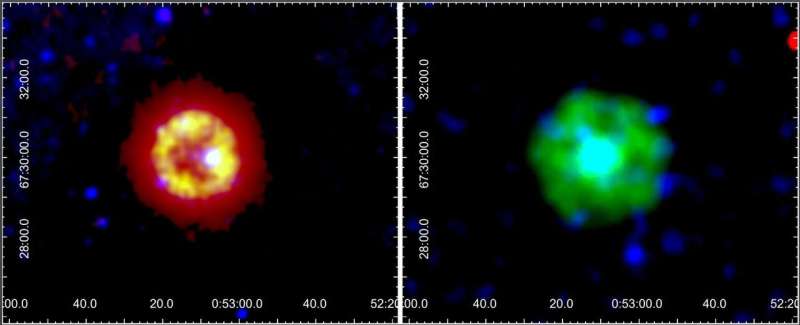January 6, 2021 report
Study of nebula IRAS 00500+6713 suggests its central star is unlike any seen before

A team of researchers from Potsdam University and Kazan Federal University has found evidence of a previously unknown kind of star in nebula IRAS 00500+6713. In their paper published in the journal Astronomy & Astrophysics, the group describes their study of the nebula and its central star and what they believe it represents.
Nebulas are clouds of dust and gas in certain regions in space—many of them can be seen with the naked eye in the night sky. Nebulas can also be associated with single or multiple star systems. In this new effort, the researchers were studying the nebula IRAS 00500+6713 because last year, another team of researchers had discovered a central star, called J005311, with a stellar wind of unusually high speeds. In taking a closer look at the star and its history, the researchers found that it had formed due to a collision between two white dwarves—an event that typically leads to a supernova and annihilation of both stars.
Prior research has also shown, however, that when such stars collide, one or both of the stars may survive—and sometimes, they merge. The researchers found evidence suggesting that J005311 had formed as a merger. But the resulting star had unique attributes. It emitted unusual X-rays and was brighter than expected, suggesting it was too massive to be a white dwarf. Further study showed the star to have a unique composition dominated by oxygen and neon. That finding suggested the star was an unstable byproduct of two white dwarves colliding without creating a new white dwarf—instead, a new kind of star was born. The researchers suggest its instability suggests it likely will not last any longer than 10,000 years.
Observations of the nebula by the team at the XMM-Newton space telescope (run by the European Space Agency) allowed them to determine its chemical composition and that of its central star. They found both contained unusual amounts of silicon, sulfur and neon. They also found evidence showing the star to be filled with very hot gas. They suggest that the star is of a type that has never been seen before.
More information: Lidia M. Oskinova et al. X-rays observations of a super-Chandrasekhar object reveal an ONe and a CO white dwarf merger product embedded in a putative SN Iax remnant, Astronomy & Astrophysics (2020). DOI: 10.1051/0004-6361/202039232
Journal information: Astronomy & Astrophysics
© 2021 Science X Network




















